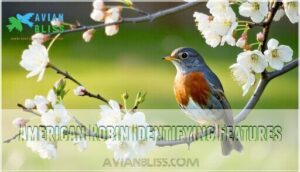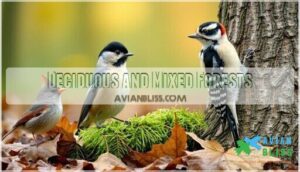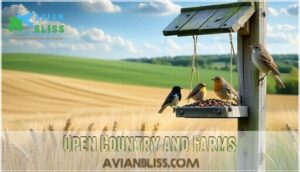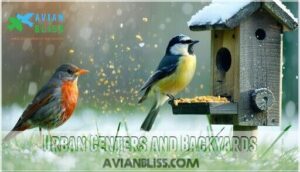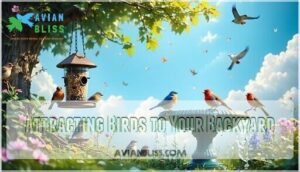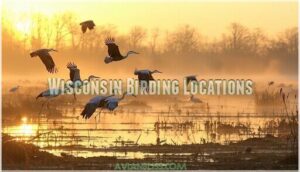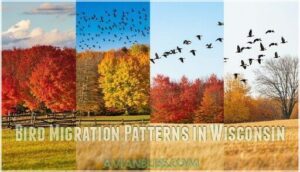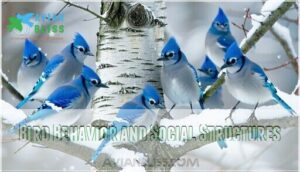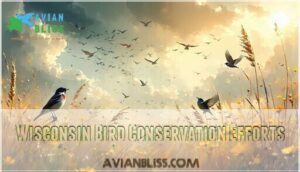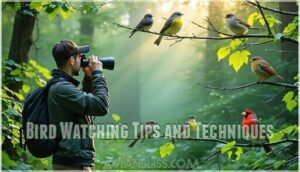This site is supported by our readers. We may earn a commission, at no cost to you, if you purchase through links.

These fearless little acrobats will eat sunflower seeds right from your palm. Northern Cardinals bring year-round color to snowy landscapes, while American Robins signal spring’s arrival with their cheerful songs.
Blue Jays dominate feeders with their bold personalities and striking blue plumage. House Finches, Mourning Doves, and White-breasted Nuthatches round out your typical backyard crew.
Each species has unique feeding preferences and habitat needs that determine where you’ll encounter them most often, making it essential to understand their requirements to attract a variety of birds, including the fearless little acrobats and those with bold personalities.
Table Of Contents
- Key Takeaways
- Common Birds in Wisconsin Overview
- Wisconsin Bird Identification
- Bird Habitats in Wisconsin
- Attracting Birds to Your Backyard
- Wisconsin Birding Locations
- Bird Migration Patterns in Wisconsin
- Bird Behavior and Social Structures
- Wisconsin Bird Conservation Efforts
- Bird Watching Tips and Techniques
- Frequently Asked Questions (FAQs)
- What are the most common backyard birds in Wisconsin?
- Are there birds in Wisconsin?
- Are blackbirds common in Wisconsin?
- Are there bluebirds in Wisconsin?
- How many birds breed in Wisconsin?
- What do wild birds look like in Wisconsin?
- What is Wisconsin’s state bird?
- When it comes to birds in Wisconsin, what’s the most common?
- In Wisconsin, how many different bird species are there?
- What is the most common bird in Wisconsin?
- Conclusion
Key Takeaways
- You’ll spot Black-capped Chickadees most often – appearing in nearly 50% of all Wisconsin bird sightings, these fearless acrobats will eat sunflower seeds from your palm and visit feeders year-round.
- Wisconsin hosts 455 bird species – from common backyard visitors like Northern Cardinals and American Robins to rare species like Golden Eagles, giving you diverse birding opportunities across different habitats.
- You can attract birds with the right setup – offering sunflower seeds, suet, fresh water, and proper shelter will draw species like Blue Jays, House Finches, and Mourning Doves to your backyard.
- Migration patterns create seasonal viewing opportunities – spring brings spectacular warbler migrations from March to June, while year-round residents like chickadees and cardinals provide consistent winter birding.
Common Birds in Wisconsin Overview
Wisconsin hosts 455 bird species.
The Black-capped Chickadee appears in nearly half of all sightings at 49.96% frequency. You’ll spot these common residents year-round.
From the bright red Northern Cardinal to the cheerful American Robin that serves as the state bird.
Birds With Frequencies Between 38% and 20%
You’ll discover Wisconsin’s medium-frequency birds bring constant backyard excitement.
Mourning Dove (38.25%) offers gentle cooing, while Blue Jay (38.15%) provides brilliant blue flashes.
Red-winged Blackbird (34.89%) displays striking shoulder patches, Downy Woodpecker (34.69%) drums rhythmically, and Song Sparrow (29.77%) delivers melodic tunes.
These Wisconsin birds create perfect opportunities for bird identification and bird watching.
Wisconsin’s diverse habitats make every backyard visit a potential birding adventure.
- Mourning Dove’s soft gray body with distinctive black wing spots
- Blue Jay’s intelligent mimicry of other backyard birds’ calls
- Red-winged Blackbird’s territorial displays in wetland areas
- Downy Woodpecker’s acrobatic feeding on tree bark
- Song Sparrow’s varied musical phrases throughout seasons
Birds With Frequencies Less Than 15.25%
Beyond the familiar backyard favorites, Wisconsin’s rare species tell compelling stories of survival and adaptation.
Ravens, at just 4% frequency, showcase remarkable intelligence in northern woodlands. Golden Eagles, even rarer at 0.1%, soar near Lake Superior with eight-foot wingspans.
Wisconsin’s wilderness holds secrets—from brilliant Ravens solving puzzles to majestic Golden Eagles ruling Lake Superior’s skies.
These declining populations face serious conservation challenges from habitat loss and climate change.
Regional variations matter—what’s common in Milwaukee might be scarce up north.
Wisconsin birds like Northern Flickers and Indigo Buntings reward patient birdwatching with stunning displays. Bird identification becomes more exciting when you spot these uncommon common species in diverse bird habitats across the state.
Wisconsin Bird Identification
You’ll find identifying Wisconsin’s common birds easier when you know their key features.
Look for the Black-capped Chickadee’s distinctive black cap and white cheeks.
The American Robin’s orange breast, the Northern Cardinal’s bright red plumage, and the Blue Jay’s blue crest and white markings are also notable features.
Black-capped Chickadee Characteristics
You’ll recognize Wisconsin’s most common backyard birds by their distinctive black cap and white cheeks.
These Blackcapped Chickadee members showcase remarkable Chickadee Behavior through their acrobatic feeding style and fearless curiosity around humans.
Their Chickadee Diet includes insects, seeds, and suet from feeders.
Chickadee Habitat spans deciduous forests to suburban yards.
Chickadee Vocalizations feature their cheerful "chick-a-dee-dee-dee" call.
Chickadee Nesting occurs in tree cavities, making them perfect Wisconsin bird species for year-round observation.
They’re also expert foragers, as noted in this Wisconsin bird guide.
American Robin Identifying Features
Within Wisconsin’s 455 bird species, you’ll spot the American Robin by its distinctive rusty-orange breast and charcoal-gray back. This common backyard bird measures 8-11 inches long with a cheerful yellow beak.
Juvenile robins display spotted breasts unlike adults, while plumage variations include darker regional differences in northern Wisconsin populations. Males show brighter coloration during breeding season.
Robin vocalizations include their famous "cheerily-cheer-up" song and sharp "tut-tut" alarm calls. Aberrant coloration occasionally produces leucistic individuals with white patches.
Look for their upright posture while ground-foraging and their habit of cocking their heads to listen for earthworms. This Wisconsin bird species ranks among America’s most recognizable birds, making identification straightforward for any bird identification guide user.
Northern Cardinal Distinctive Traits
The Northern Cardinal stands out as Wisconsin’s most recognizable backyard visitor.
Males display vibrant plumage coloration with brilliant red feathers covering their entire body, while females show warm brown tones with subtle red tinges. This dimorphism differences helps you distinguish between sexes easily.
Both sport the characteristic black mask around their eyes and bright orange-red bills.
Cardinal vocalizations include clear whistles like "birdy-birdy-birdy" and metallic chips.
Their diet adaptations favor sunflower seeds at feeders, making them frequent Wisconsin garden guests year-round unlike migratory American robin populations.
Blue Jay Identification Tips
You’ll spot Blue Jays by their brilliant blue plumage variations and distinctive crest that rises when excited.
These intelligent birds frequent Wisconsin’s deciduous forests and backyards year-round.
Key Blue Jay identification features:
- Plumage variations – Bright blue wings and tail with white chest and black necklace markings
- Call identification – Harsh "jay-jay" calls plus mimicry of hawk sounds to scare competitors
- Habitat clues – Oak forests, parks, and suburban areas with mature trees
- Behavior patterns – Travel in family groups, cache acorns, and mob predators aggressively
- Regional differences – Wisconsin populations show slightly duller blue coloring than southern birds
Use bird identification apps to distinguish their varied vocalizations from similar species during your birdwatching adventures.
Bird Habitats in Wisconsin
Wisconsin birds call three main habitat types home across the state. You’ll spot different species depending on whether you’re exploring dense forests, open farmland, or your own neighborhood backyard.
Deciduous and Mixed Forests
You’ll discover Wisconsin’s deciduous and mixed forests teem with incredible Forest Birdsong and diverse Wisconsin bird species.
These woodlands showcase remarkable Canopy Diversity despite challenges from Forest Fragmentation and Invasive Species affecting Nesting Ecology.
Backyard ecosystems benefit from downy woodpecker foraging.
- Black-capped Chickadees flitting through oak branches with their distinctive calls
- Woodpeckers drumming rhythmic beats on maple trunks
- American Robins hopping across forest floors hunting earthworms
- Northern Cardinals adding crimson flashes to green understory shrubs
Open Country and Farms
Wisconsin’s open country and farms support diverse bird populations, including American Crow, Mourning Dove, and American Robin.
Farm Bird Diversity faces challenges from Agricultural Impact and Open Habitat Loss as modern farming reduces nesting sites. You’ll spot Farmland Birds like Red-winged Blackbirds in agricultural areas year-round.
Conservation Strategies include maintaining fence rows and grassland buffers. Bird watching enthusiasts can support backyard birds by providing bird feeders with seeds that attract these open-habitat species across Wisconsin’s rural landscapes.
Farm Bird Populations
Conservation Practices Use of bird feeders
Challenges
Urban Centers and Backyards
Urban birds make their homes right outside your door. These adaptable species have mastered City Bird Adaptations to thrive in concrete environments where Urban Birdsong fills the air year-round.
Wisconsin’s most common backyard birds include:
- American Robin – Wisconsin’s state bird loves lawns and gardens
- Northern Cardinal – Bright red males visit bird feeders daily
- Black-capped Chickadee – Acrobatic performers at suet feeders
- American Goldfinch – Yellow beauties prefer nyjer seed
- Blue Jay – Bold, intelligent birds that cache peanuts
Smart Feeder Management and bird houses create thriving Backyard Ecosystems. These Urban Conservation efforts help Wisconsin birds flourish in cities.
Attracting Birds to Your Backyard
Creating a bird-friendly backyard starts with providing three essential elements that Wisconsin’s common species need to thrive.
You can attract Black-capped Chickadees, American Robins, and Northern Cardinals by offering the right combination of food sources, shelter options, and fresh water throughout the year to create a bird-friendly environment.
Bird Feeders and Seed Types
Strategic feeder placement transforms your backyard into Wisconsin’s hottest bird hangout. Position feeders 10-12 feet from cover but away from windows.
Different seed preferences attract specific Wisconsin species – cardinals love sunflower seeds while goldfinches prefer thistle. Many enjoy offering sunflower seeds for birds in their yards.
| Bird Species | Preferred Seeds | Feeder Type |
|---|---|---|
| Northern Cardinal | Sunflower seeds | Platform/hopper |
| American Goldfinch | Thistle/nyjer | Tube feeder |
| Black-capped Chickadee | Sunflower/suet | Multiple types |
| Blue Jay | Peanuts/corn | Platform feeder |
Regular feeder maintenance prevents mold and disease. Clean feeders every two weeks with diluted bleach solution. Squirrel deterrents like baffles keep these acrobats from raiding your bird buffet.
Birdhouses and Nesting Sites
Why settle for just feeding birds when you can offer them safe nesting homes? Quality bird houses require proper Birdhouse Materials like untreated cedar or pine.
Follow these Placement Strategies:
- Mount boxes 5-15 feet high based on species preferences
- Face entrances away from prevailing winds and afternoon sun
- Install Predator Protection like baffles or smooth poles
- Space multiple boxes at least 25 feet apart
Clean annually after Wisconsin breeding season ends. Smart Nesting Box Design creates thriving backyard habitats.
Water Sources and Bird Baths
After setting up birdhouses, you’ll want to add bird baths to complete your Wisconsin birdwatching setup. Choose shallow bowls with rough surfaces for better grip. Place them in shaded areas away from predators for safety.
| Feature | Summer Setup | Winter Setup |
|---|---|---|
| Water depth | 1-2 inches | Add heater |
| Cleaning frequency | Every 3 days | Weekly |
| Bird preferences | Moving water | Consistent access |
Water cleanliness prevents disease spread among bird species. Bath placement matters – Wisconsin birds prefer quiet spots near cover. Winter water requires heated elements to stay unfrozen. DIY baths work well using simple materials.
Regular maintenance attracts more visitors to your backyard sanctuary. This includes ensuring the water is clean and the bath is placed in an ideal location, providing consistent access to water for the birds.
Wisconsin Birding Locations
Wisconsin offers over 200 premier birding locations where you can spot the state’s 455 bird species throughout the year.
From Horicon National Wildlife Refuge’s massive Sandhill Crane gatherings to Crex Meadows’ prairie specialists, these hotspots provide reliable opportunities to observe both common residents and rare migrants, showcasing the state’s diverse bird species.
State Parks and Nature Reserves
Wisconsin’s state parks offer prime birdwatching locations with diverse Reserve Habitats supporting hundreds of bird species.
Birding Trails wind through Park Birdlife zones where you’ll spot everything from cardinals to warblers.
Seasonal Variations bring migrating species during spring and fall.
These Wisconsin bird habitats showcase Conservation Roles protecting native populations while providing accessible Wisconsin birdwatching opportunities for all skill levels.
National Wildlife Refuges
Within Wisconsin’s national wildlife refuges, you’ll discover exceptional refuge birding opportunities across diverse refuge habitats.
These protected areas showcase successful refuge conservation through dedicated refuge management practices, despite ongoing refuge threats from climate change.
Here are three compelling reasons to visit these birdwatching locations:
- Observe over 200 bird species thriving in carefully managed Wisconsin wetlands and grasslands
- Experience Wisconsin wildlife conservation success stories firsthand through guided tours
- Document rare bird habitats in Wisconsin while supporting ongoing protection efforts
Local Birding Hotspots
Beyond national refuges, you’ll find Wisconsin’s birdwatching hotspots scattered across diverse landscapes.
Marsh Birding at Horicon offers unmatched waterfowl viewing, while Forest Hotspots like Kettle Moraine provide warbler migration spectacles.
Lakeside Viewing at Pike Lake attracts year-round residents and seasonal visitors.
Don’t overlook Urban Birding opportunities in parks and neighborhoods.
These Wisconsin birdwatching locations deliver Rare Sightings and reliable species encounters, making your birdwatching in Wisconsin adventure unforgettable.
Bird Migration Patterns in Wisconsin
Wisconsin’s birds follow predictable migration routes that change with the seasons, offering you excellent viewing opportunities throughout the year.
You’ll find that some species stay put while others travel thousands of miles, creating a dynamic birding calendar that keeps every season interesting.
Spring Migration
After exploring Wisconsin’s top birding locations, spring brings nature’s most spectacular show.
Peak Wisconsin bird migration occurs from late March to early June when migratory birds follow established bird migration routes. Weather patterns affect arrival dates substantially, with southern regions experiencing earlier activity than northern areas.
Many species rely on visual landmarks for navigation during their journeys.
Here are five key spring migration highlights:
- Arrival Dates vary by species – robins arrive in March while warblers appear in May
- Nesting Preparation begins immediately after arrival with territory establishment
- Mating Rituals peak during late April through early June across Wisconsin
- Song Changes become more complex as males compete for mates
- Food Availability drives timing as insects emerge with warming temperatures
Fall Migration
Fall migration transforms Wisconsin from late August through early November as migratory birds follow established bird migration routes southward.
Weather impacts like cold fronts trigger massive movements, while stopover sites in forests and wetlands provide essential refueling stations.
You’ll spot waterfowl, hawks, and sparrows using navigation methods like celestial cues.
Join citizen science projects to track these remarkable bird migration patterns.
Year-Round Residents
How do Northern Cardinals and Black-capped Chickadees survive Wisconsin’s harsh winters?
These resident adaptations include changing diets and flocking behavior for winter survival.
American Robin populations show interesting territory defense patterns year-round.
Breeding habits vary among species, with some starting courtship in late winter.
Understanding these population trends enhances your bird identification skills and birdwatching tips for observing bird behavior.
Bird Behavior and Social Structures
When you observe Wisconsin’s birds throughout the year, you’ll notice fascinating patterns in how they interact with each other and their environment.
From the complex social hierarchies of Blue Jay flocks to the intricate courtship dances of American Robins, these behaviors reveal the remarkable intelligence and adaptability that help birds thrive in Wisconsin’s diverse ecosystems.
Flocking Behavior
When you watch Wisconsin birds, you’ll notice flocking behavior serves essential survival functions.
Birds gather in groups for Predator Avoidance – more eyes spot danger faster.
This bird behavior also improves Foraging Efficiency through shared knowledge of food sources.
Key Flock Benefits include:
- Enhanced predator detection and group defense
- Improved foraging success through information sharing
- Social Hierarchy establishment within groups
- Flock Communication through calls and visual signals
Different bird species behavior shows varying flock sizes.
Wisconsin bird behavior changes seasonally, with larger winter flocks.
These birdwatching tips help you understand bird frequency patterns you observe.
Mating and Breeding Habits
Wisconsin birds showcase fascinating Mating Displays and Nesting Rituals that vary dramatically between species.
Bird courtship involves elaborate dances, songs, and colorful plumage shows. After pairing, couples select bird nests locations in suitable habitats.
Egg Laying typically occurs in spring, followed by Chick Development through dedicated Parental Care during bird breeding season.
| Species | Nesting Location | Breeding Season |
|---|---|---|
| Black-capped Chickadee | Tree cavities | April-June |
| American Robin | Tree branches | March-July |
| Northern Cardinal | Dense shrubs | March-September |
| Blue Jay | Tree forks | April-July |
| American Goldfinch | Shrub branches | June-September |
Communication and Song Patterns
Why do birds sing? Bird vocalizations serve multiple purposes beyond simple communication.
The American robin’s melodic song establishes territory and attracts mates during breeding season.
Understanding bird communication patterns reveals fascinating behaviors:
- Vocal Mimicry – Species like mockingbirds copy other bird sounds and environmental noises
- Alarm Calls – Sharp, urgent notes warn flock members of predators or danger
- Song Dialects – Regional variations in bird songs create distinct "accents" across populations
Duetting behavior occurs when paired birds coordinate their calls, creating complex avian language patterns.
Wisconsin Bird Conservation Efforts
Wisconsin’s bird populations face serious challenges from habitat loss and climate change that threaten species like the Bobolink and Henslow’s Sparrow.
You can help protect these birds through conservation programs that restore prairies, preserve wetlands, and create climate-resilient habitats across the state.
Threatened and Endangered Species
Five bird species face serious threats in Wisconsin.
The Kirtland’s Warbler shows population increases through conservation strategies, while Piping Plovers remain stable with legal protections.
Bald Eagles demonstrate successful bird conservation efforts.
However, Henslow’s Sparrow and Cerulean Warbler populations decline due to habitat loss.
Public awareness campaigns and bird species protection programs help combat these challenges effectively.
Habitat Loss
Climate Change
Poaching Threats
Habitat Preservation and Restoration
You can make a real difference in protecting Wisconsin’s bird populations through targeted conservation actions.
Land Preservation creates safe corridors that combat Habitat Fragmentation, allowing birds to move between isolated patches.
Wetland Conservation restores critical stopover sites for migrating species, while Forest Ecosystems protection maintains nesting grounds.
Wisconsin bird conservation efforts focus on Climate Resilience strategies that help habitats adapt to changing conditions.
Support local bird conservation initiatives through habitat restoration projects in your community.
Community Involvement and Education
Your involvement matters in Wisconsin’s birdwatching community.
Join citizen science projects like the Great Backyard Bird Count or Christmas Bird Counts. Support educational programs at nature centers and schools.
Attend community workshops through local Audubon chapters. Youth birding clubs need mentors.
Partner with Wisconsin organizations to protect habitats. Every birdwatching enthusiast strengthens conservation efforts.
These initiatives often align with environmental literacy standards.
Bird Watching Tips and Techniques
You’ll need the right gear and know-how to spot Wisconsin’s 455 bird species effectively.
Start with quality binoculars and reliable field guides, then join local birding groups to learn from experienced watchers.
Binoculars and Spotting Scopes
Quality birdwatching equipment transforms your Wisconsin birding adventures.
Choose binoculars with 8×42 Magnification Power for steady viewing and wide Field of View. Look for:
- Lens Coatings: Multi-coated optics provide brighter, sharper images
- Image Stabilization: Reduces hand shake for clearer bird identification
- Budget Options: Entry-level models under $200 offer excellent value
Consider binoculars with enhanced stabilization systems for superior viewing.
Proper birdwatching resources help you spot Wisconsin’s 455 species more effectively.
Field Guides and Identification Apps
Digital tools transform Wisconsin bird identification into an accessible adventure.
Birdwatching apps offer real-time App Accuracy with sound recordings and photos, while traditional Guide Features provide detailed illustrations.
Digital vs. Print comes down to convenience versus depth.
For those interested in purchasing, there are Wisconsin bird app products available.
Beginner Resources include user-friendly apps, while Advanced Techniques favor thorough field guides for serious Wisconsin bird identification.
Birding Tours and Workshops
Wisconsin birdwatching tours and workshops offer hands-on learning from expert guides who know local hotspots and species behavior.
You’ll discover seasonal tours that showcase spring migrations or winter residents, plus custom tours adapted to your skill level.
These Wisconsin birdwatching events teach workshop skills like proper binocular techniques and bird identification methods.
Consider these tour logistics when planning:
- Seasonal tours for peak bird activity periods
- Expert guides providing local knowledge and identification tips
- Custom tours matching your experience level and interests
- Workshop skills including field techniques and equipment use
Frequently Asked Questions (FAQs)
What are the most common backyard birds in Wisconsin?
Like a colorful parade marching through your yard, Wisconsin’s most common backyard birds include Black-capped Chickadees, American Robins, American Goldfinches, Northern Cardinals, and Blue Jays.
You’ll spot these feathered friends year-round at feeders.
Are there birds in Wisconsin?
Yes, Wisconsin hosts 455 bird species.
You’ll spot common ones like Black-capped Chickadees, American Robins, and Northern Cardinals year-round.
From tiny goldfinches to majestic Bald Eagles, the state’s diverse habitats support an amazing variety of feathered friends.
Are blackbirds common in Wisconsin?
Red-winged Blackbirds are quite common in Wisconsin, appearing in about 35% of bird sightings.
You’ll spot these black birds with distinctive red shoulder patches in forests, wetlands, and backyards throughout the state year-round.
Are there bluebirds in Wisconsin?
Bright as sapphires against summer skies, Eastern Bluebirds do inhabit Wisconsin’s open woodlands and meadows.
You’ll spot males with vibrant blue backs and rusty orange chests perched on fence posts, hunting insects and enjoying berries throughout the warmer months.
How many birds breed in Wisconsin?
Wisconsin hosts 243 confirmed breeding bird species according to the state’s Breeding Bird Atlas.
You’ll find everything from common backyard nesters like robins and cardinals to rare species documented by over 2,000 dedicated volunteers, including those that are confirmed breeding bird species.
What do wild birds look like in Wisconsin?
Wild birds you’ll spot in Wisconsin display striking colors and patterns.
Black-capped Chickadees have white cheeks with black caps.
American Robins show orange breasts.
Cardinals flash bright red plumage.
Goldfinches gleam yellow with black wings, and together these birds showcase a variety of striking colors.
What is Wisconsin’s state bird?
You’ve probably wondered about Wisconsin’s official bird since seeing so many different species around the state.
Wisconsin’s state bird is the American Robin, which you’ll recognize by its distinctive orange breast and brown back.
It’s been the official state bird since
When it comes to birds in Wisconsin, what’s the most common?
Black-capped Chickadees top Wisconsin’s bird charts at nearly 50% frequency.
You’ll spot these friendly little acrobats with their distinctive black caps and white cheeks practically everywhere—from backyard feeders to deep forests throughout the state, making them a common sight.
In Wisconsin, how many different bird species are there?
You’ll find 455 different bird species in Wisconsin.
That’s quite a diverse collection for one state.
From tiny chickadees to majestic eagles, Wisconsin’s varied habitats support an impressive range of feathered residents and visitors throughout the year.
What is the most common bird in Wisconsin?
Picture yourself at your backyard feeder on a crisp morning – that cheerful "chick-a-dee-dee-dee" call you’ll hear belongs to Wisconsin’s most common bird.
The Black-capped Chickadee appears in nearly 50% of all bird sightings statewide, making it your most reliable feathered neighbor, with its presence noted in almost half of all bird sightings.
Conclusion
Wisconsin’s wild backyard theater continues year-round, offering you front-row seats to nature’s daily drama.
Whether you’re spotting your first Black-capped Chickadee or watching Cardinals paint winter landscapes red, these common birds in Wisconsin transform ordinary moments into extraordinary encounters.
You’ll discover that patience and observation reveal secrets of their fascinating behaviors.
Your backyard becomes a sanctuary where science meets wonder, and every season brings new avian performers to appreciate and protect.
- https://datacentral.kitsapsun.com/most-sighted-winter-and-spring-birds/location/wisconsin/55/may/
- https://www.nature.org/en-us/about-us/where-we-work/united-states/wisconsin/stories-in-wisconsin/bird-watching/
- https://www.audubon.org/climate/survivalbydegrees/state/us/wi
- https://bwdmagazine.com/travel/regions/10-highlight-birds-wisconsin/
- https://dnr.wisconsin.gov/topic/EndangeredResources/BirdAtlas


